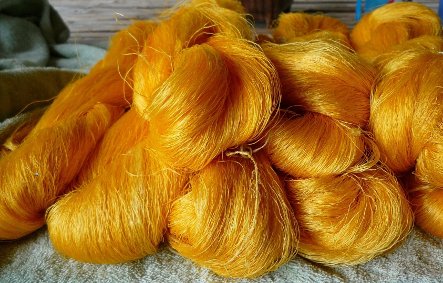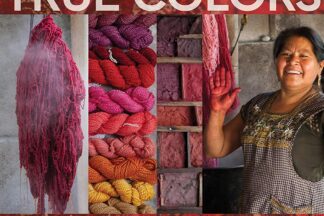Looking at the sales figures of luxury brands a single conclusion can be drawn: The luxury sector is doing well.
The structure of its customers, and the brands' efforts to maintain expert craftsmanship suggests that the luxury sector is where ethical brands really can start changing the world.
'Make it British', or the equivalent: French, Italian, German, Spanish ..., is often talked of as the ultimate panacea to address the lack of sustainability in the fashion industry. A few reasons why it all is slightly more complicated than it sounds.
This article has originally been published online by ‘Japan for Sustainability’ (JFS) on May 30, 2005. It is the 1st...
Starting in 1866, a shoe factor by the name of William Green came regularly from Northamptonshire up to the City of London to get orders and then take them back to Rushden where, in 1874, he opened his first factory as William Green & Son, founding the company we know today as Grenson.
'Africa' & 'Fashion' in one sentence, usually evokes the picture of the cliché matron wearing an attire in recognisable prints. To prove that these may indeed just be nothing but clichés, and that there is much much more to African Fashion, is this book's mission
The factory of James Ince & Sons, the oldest established umbrella makers in the country. Currently owned by the 7th generation, it has not only been around since the invention of the umbrella, but is responsible for the umbrella designs for Marry Poppins as well as Hagrid.
With Sao Paulo Fashion Week just closed I am here to write (again) about Brazilian fashion.
This time it is about an interesting project I got to know of personally, Projeto Contem, a private and independent initiative.
Projeto Contem is both a brand and a network of entrepreneurs working in textile and fashion as well as in food, beauty, design, arts, music and cinema.
Drakes is synonymous around the world with the most beautiful silk ties that money can buy. Founded thirty years ago on a top floor in Old Bond St and operating from a former Royal Mail depot in Old St for the past twenty, Drakes brought manufacturing back to the East End. A portrait.
Sawang Boran is a social community business in the Thailand. They use traditional skills to produce high-quality hand-woven silk ikat fabric made of golden Isan silk.
The current fashion and textile landscape is fairly limited in terms of what types of materials are being used. Innovation is key, and products such as Tencel, Sorona and Ingeo proof that industry is investing heavily in R&D. Spider Silk may be one of the few natural fibres of the future yet to see it hayday.
For retail, Brazil is the ‘next hot’ place to go to.
For a variety of reasons: For one, the country’s economy has been for a long time up and raising. Brazil is one of the 4 BRIC countries – the 4 most dominant raising economies, and ranks forth among them. Its retail sector is expected to boom tremendously over the next few years owing largely to the two major global sport events – the 2014 FIFA World Cup and Rio 2016 Summer Olympics that will take place in the country.
Nigeria’s textile industry used to be – possibly still is – the African continent’s third largest after that of Egypt and South Africa. For one reason or another, the first two are fairly well established among brands of all colours and types as potential – and actual – sourcing destinations. Egyptian cotton is well renowned, as is their industry for jersey goods. Also ‘Made in South Africa’ is not uncommonly found in clothing labels.
Julius Walters of Stephen Walters & Sons is a ninth generation weaver of a family business founded 1720. This is the company that wove the silk for the Queen’s coronation robes and for Princess Diana’s wedding dress.
Laces have been a firm part of haute-couture since the medieval, and the fabric still is, and always has been, a luxury product. The StGall exhibition in Switzerland pays tribute to 800 years of lace work featuring the best of European textile artisanry and technology.
One by one European manufacturers go out of business, and with them a vast quantity of skills and knowledge is lost. The most recent example is Switzerland's Weisbrod silk weavery. Yet: it seems the tide is changing, for good reason.
Report by Jacqueline Shaw from Africa Fashion Guide, on a recent visit to The Gambia and the textile history and techniques she encountered during her stay.
Cotton as an attractive alternative in tsunami regions. Leading textile manufacturers promoting the cultivation of organic cotton. New technologies and methods for natural dyeing processes and recycling. And five categories of Green Fashion in Japan.
The Spitalfields taylors Alexander Boyd is London's last shirt maker. All their shirts are made at the Rayner and Sturges factory in Kent. Impressions from the factory, and the 'making of' a bespoke Savile Row shirt.
Arabel Lebrusan trained in the art of jewellery in the most prestigious European schools, and has collaborated throughout her career in projects with international companies such as Swarowski. Today, she leverages all her experiences and her knowledge about artisanal techniques, apply them to contemporary designs.
Daring to ask and daring to understand: the key ingredients that turn a passive customer in an active (activist) participant in our market economy. This book portrays 26 natural dye artisans, in beautiful pictures, honouring their skill and wisdom.



